EDM Audience Analysis in 2022.
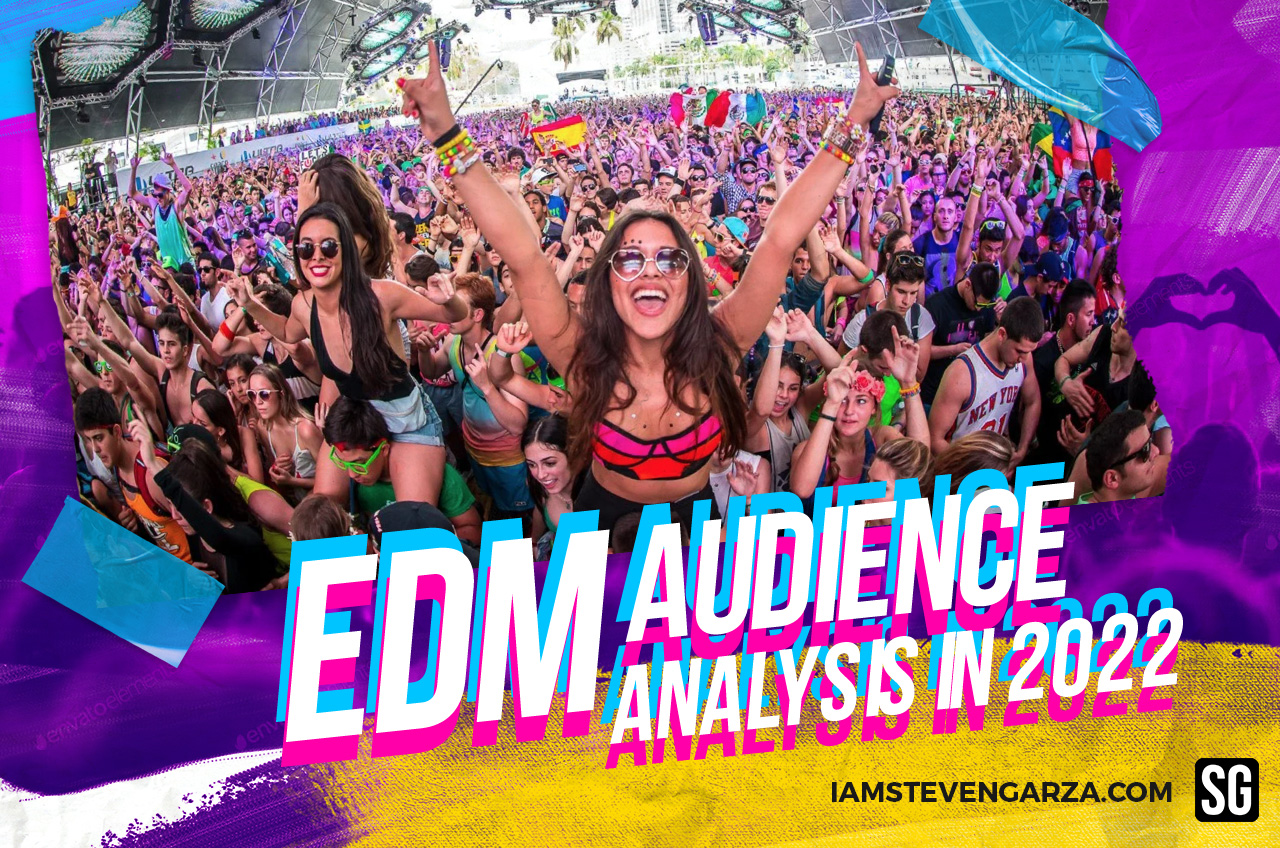
The Electronic music industry continues to boom, partly thanks to the continued advances in technology in how we share, stream and consume our favorite tracks. The most innovative companies are already benefiting from technological possibilities, from discovering up-and-coming talent on social media platforms to creating more personalized marketing strategies and working with related brands that can lead to more profitable partnerships.
Audience intelligence and big data are transforming many sectors, and music is no exception.
“All our business units must now leverage data and analytics in innovative ways to dig deeper than ever for new talent. The modern-day talent-spotter must have both an artistic ear and analytical eyes.”
Rob Stringer, CEO of Sony Music
Consumer insight empowers you to go beyond assumptions and use real-time data to form the backbone of your marketing and publicity strategies. For example, in A&R (Artists and Repertoire) departments, decision-making no longer depends solely on someone having a “good ear”, but the data that presents provides concrete information about, for example, the tastes of the consumers.
This is not just useful for the teams responsible for discovering new talent. Accurate consumer insight opens a whole world of possibilities for data-based marketing strategies: from identifying locations for events in your most enthusiastic locations or finding brands and influencers to spread the word. The possibilities are unlimited, you just have to select which audience segments you’re most interested in and start gathering data!
As spring approaches and restrictions begin to ease in some parts of the world, festival-goers are excited about the imminent return of festivals and concerts.
New call-to-action Identifying EDM industry audience to help better identify the audience of the EDM industry while ranking of the 100 best record labels. Using this as the starting point, we identified profiles of individuals that featured any of these names in their Twitter bio, giving us more than 2,600 profiles within the sector: labels, producers, DJs, and other professionals with an active interest in the industry.
What are the key characteristics of the EDM industry?
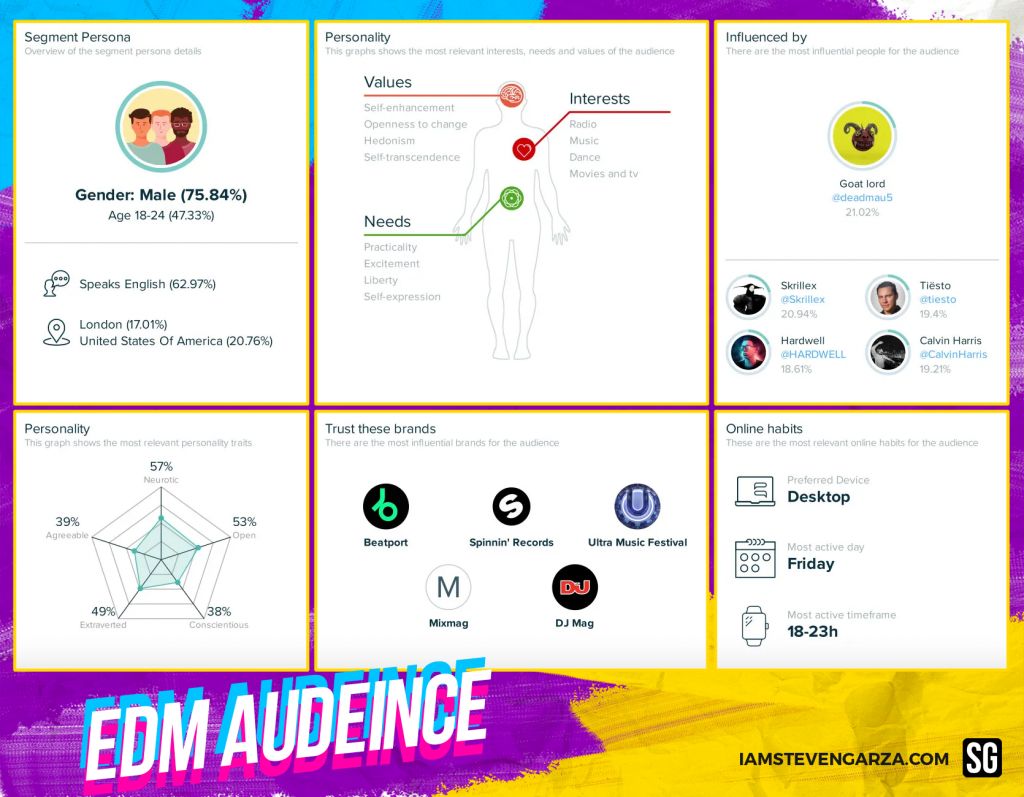
Data shows that the EDM industry is predominantly male (75%) and largely based in the US and UK (20% in the US and 18% in the UK respectively), with high levels of engagement in the Netherlands, Germany, and Spain. With this insight, it’s probably safe to assume that Europe is one of the central hubs of the industry.
Diving deeper into city-specific data, London leads the way, accounting for 17% of the audience, closely followed by Los Angeles, Amsterdam, Vancouver, Miami, and Barcelona. Interestingly, while English is the primary language spoken by this audience, there is also a lot of conversation happening in Spanish, German, Japanese, and Dutch!
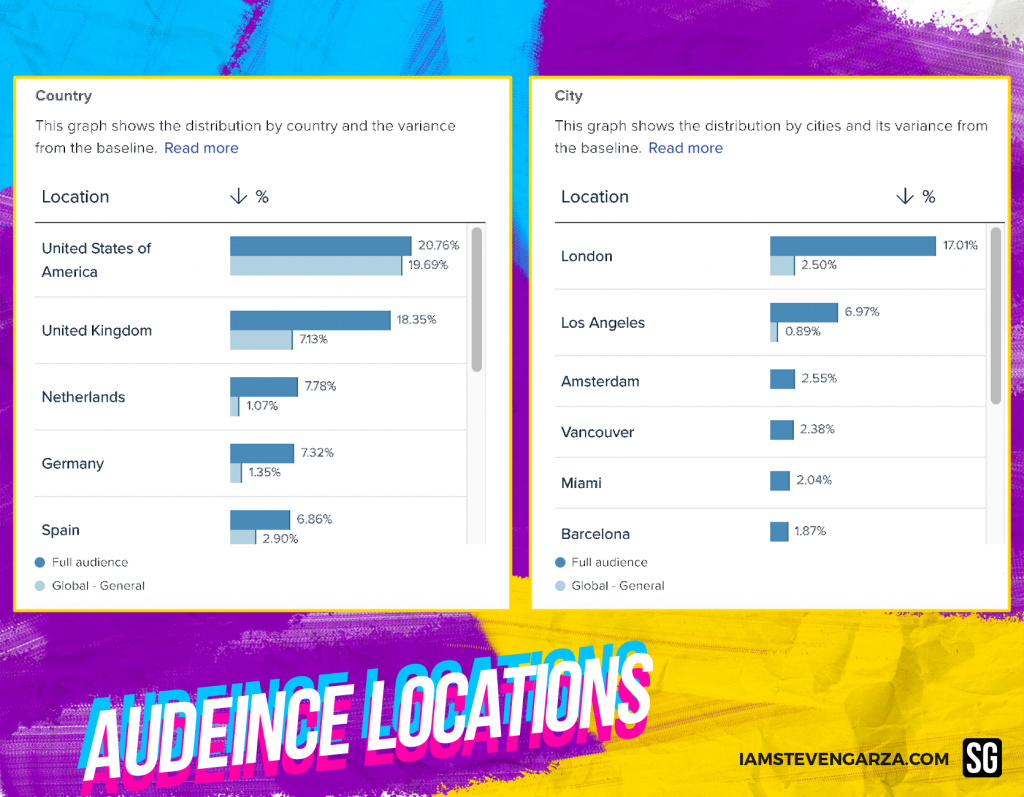
Compared to the rest of the global population, it might not surprise you to hear that this audience is especially interested in radio, music, dance, and EDM-related events. However, if you were interested in extending your reach to find new fans, it could also be useful to note that they love movies, TV, and sports.
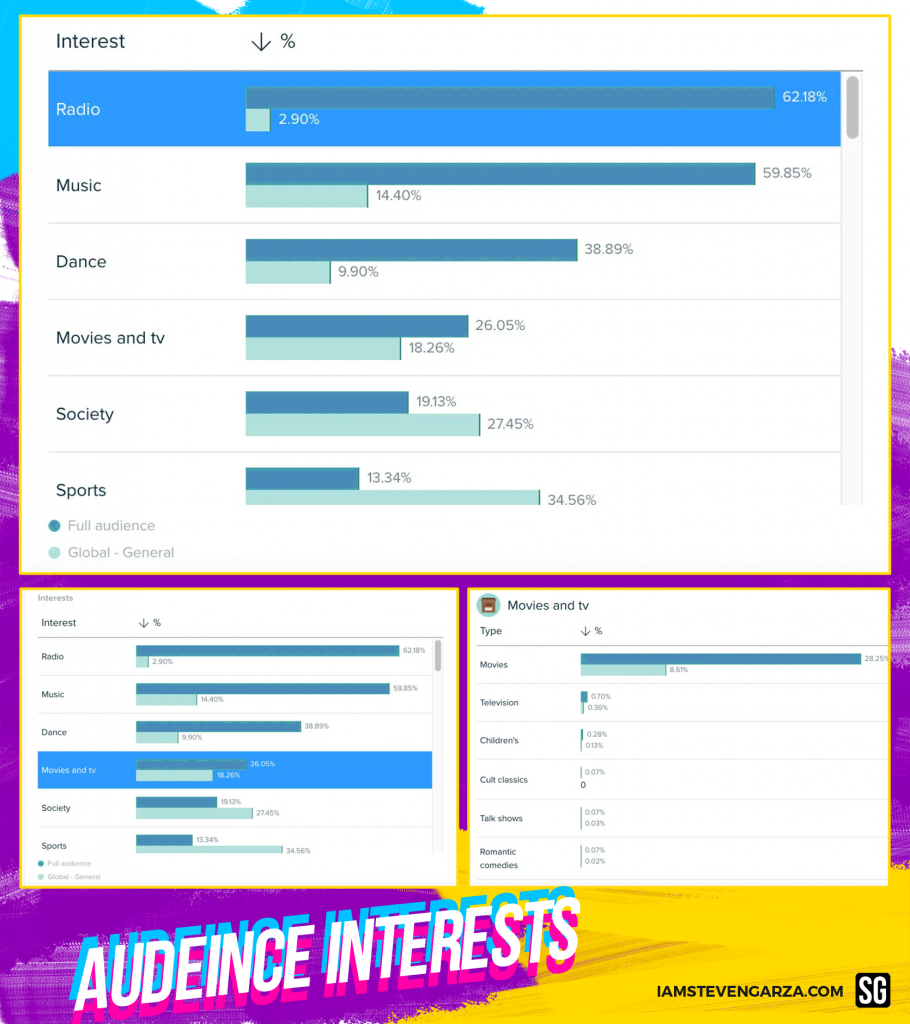
So, where are EDM Audiences spending the most time online? Well, they’re significantly more likely to be using a desktop rather than a mobile – an unusual insight given the general trend toward mobile browsing – and they’re also 78 times more likely to be browsing SoundCloud than any other platform! But not on Saturdays or Sundays, because they’re out on the dance floor. They’re also heavy users of Twitch, Snapchat, Spotify, and TikTok – everyone’s favorite emerging network that makes heavy use of popular sounds.

Who are the biggest influencers in the EDM industry?
After identifying the most influential profiles, Audiense Insights created several rankings in different categories, taking as a criteria the “uniqueness” of each person / brand to the analyzed audience compared to a concrete baseline (in our case, the global population). Without further ado, here’s the Audiense round-up of the top DJs, producers, festivals, and clubs in the industry.
Top 10 Influencers
This first is the general ranking with the top 10, without separating by categories.
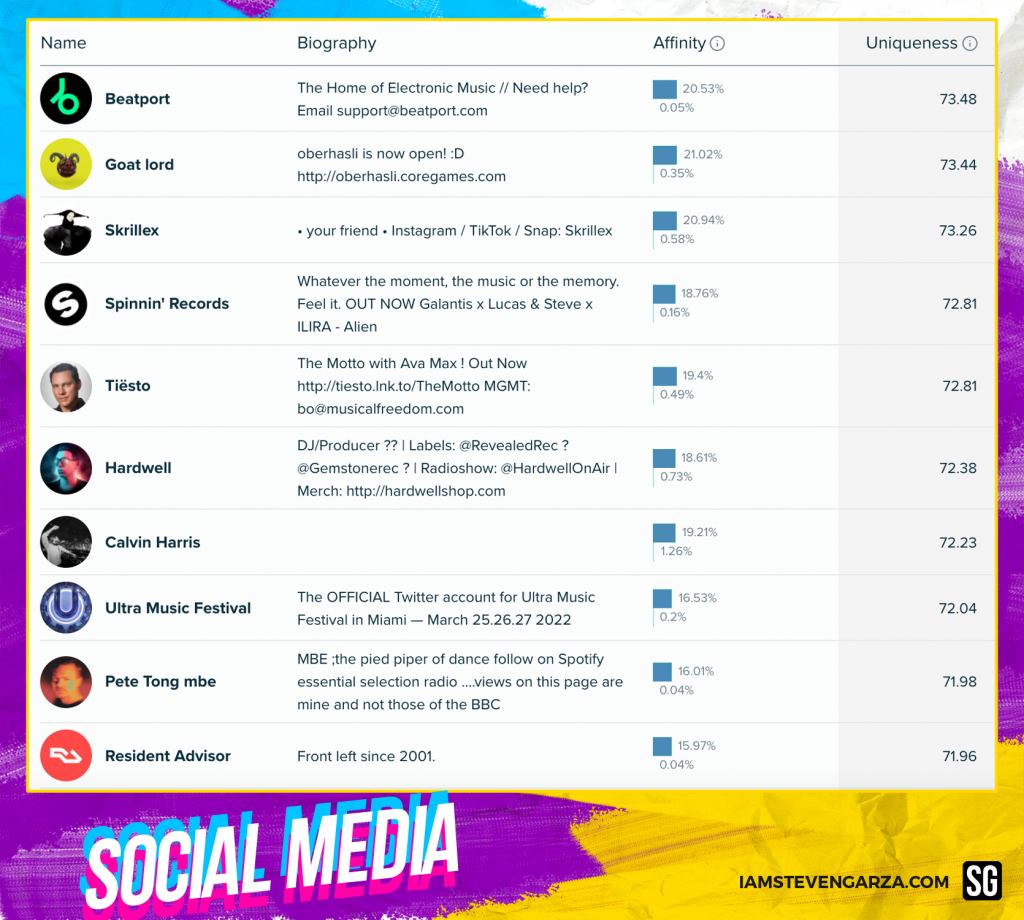
Top 30 DJs / Producers / Artists
- Deadmau5
- Skrillex
- Tiësto
- Hardwell
- Calvin Harris
- Pete Tong
- Carl Cox
- Diplo
- Martin Garrix
- Zedd
- Nicky Romero
- Afrojack
- Steve Aoki
- Axwell
- Dillon Francis
- Alesso
- Knife Party
- Steve Angello
- Sebastian Ingrosso
- Laidback Luke
- Richie Hawtin
- Tim Bergling
- Porter Robinson
- Armin van Buuren
- Kaskade
- Eric Prydz
- W&W
- Dimitri Vegas
- Sander van Doom
- David Guetta
Top 20 Record Labels
- Spinnin’ Records
- Monstercat
- Ultra Music
- Defected Records
- Armada Music
- Toolroom
- Ministry of Sound
- OWSLA
- Revealed Recordings
- Dirtybird Records
- Drumcode Records
- Hot Creations
- MAD DECENT
- Get Physical Music
- Warp Records
- Suara
- Crosstown Rebels
- Musical Freedom
- Anjunabeats
- Protocol Recordings
Top 4 Music Platforms
- YouTube
- SoundCloud
- Spotify
- Mixcloud
Top 10 Festivals / Events
- EDC Las Vegas
- Ultra Music Festival
- Tomorrowland
- BOILER ROOM
- Amsterdam Dance Event
- Red Bull Music Academy
- The Warehouse Project
- BPM Festival
- Sónar Festival
- Elrow
Top 10 Clubs
- Ministry of Sound
- Fabric London
- Space Ibiza
- Pacha
- Amnesia Ibiza
- Berghain
- Ushuaïa Beach Hotel
- Cafe Mambo Ibiza
- Octan Ibiza
- Circoloco Ibiza
Top 3 Radio Stations and 3 Radio Shows
- BBC Radio 1
- Rinse FM
- Ibiza Sonica
- Essential mix
- A State of Trance
- R1Dance
Top 10 Media / Online Communities
- MixMag
- DJ Mag
- Resident Advisor
- Dancing Astronaut
- XLR8R
- FACT
- BE-AT.TV
- THUMP (Vice)
- Pitchfork
- Your EDM
Electronic music is the world’s third most popular genre
A study in 2019 by the IMS Business Report found electronic music to be the third most popular music genre, with an estimated 1.5 billion listeners.
A third of the 19,000 people asked said they typically listen to Electronic, dance, and House music, ranking it ahead of Hop Hop, Rap, and R&B.
Pop and rock music were the most listened to genres in the survey, which was sent to 16 to 64-year-olds in 18 different countries.
Elsewhere in the report, another study found that female artists only account for 19 percent of performers in the 20 biggest multi-genre festivals.
EDM Fans on Social Media
Fans of Electronic Dance Music post more than 70 million conversations through their social networks.
EDM fans’ social sharing is fueling the movement. Part of the explosive momentum behind EDM can be attributed to frequent social sharing; EDM fans tweeted a staggering 11 times per day (roughly six times more than the average Twitter user, who tweets 1.85 times per day). EDM fans post 30 percent more about concerts compared to other music fans, indicating their desire to share about the live experience.
EDM fans are all music, all the time. In fact, one-third of all social media posts by EDM fans were about electronic music. The conversations are also rooted in positivity. Forty percent of all EDM conversations on social media were focused on a love of EDM, propelling the discovery and sharing of the music and events in the space.
EDM fans live for the live experience. A whopping 1 in 4 social posts about EDM occurs during a live electronic music event. This massive volume of conversation adds up to 42 billion potential impressions for EDM events in just one year and shows that the live experience holds great significance for this audience.
